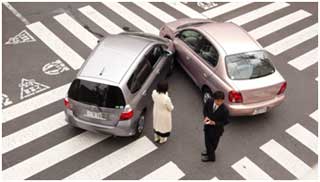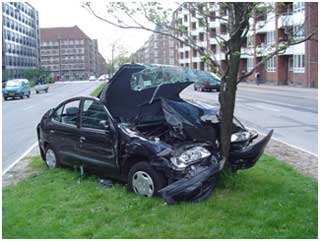Crash Reconstruction Physics

A man and woman after a car accident.
Photo by Shuets Udono

A car accident where the driver ran
into a tree.
Few physics experiments come with greater consequences than those done by a police crash reconstruction team.
If they fail to calculate the proper drag coefficient or slope angle, they could either let a criminal go free or jail an innocent person.
Several years ago, Sgt. Gene Shantz of the Flagstaff Police Department's crash reconstruction team kept a cocaine dealer hauling millions of dollars worth of the drug from going free. The suspect was driving a rental car on the interstate when he was stopped for following the vehicle in front of him too closely. Officers eventually discovered five kilograms of cocaine inside the trunk using drug sniffing dogs.
A defense attorney asked the judge to throw the case out, claiming that the stop was unconstitutional because his client was far enough behind the car in front of him to avoid an accident.
Shantz used basic physics in court to show that the suspect would have had only a second or so to react if the driver in front of him had slammed on their brakes. The judge was convinced the suspect was following too closely and dismissed the motion and the man was eventually found guilty of drug trafficking (though the conviction was later thrown out for other reasons).
Shantz's passion for accident reconstruction goes back to his days in the Boy Scouts when he was part of the Arizona Highway Patrol's Explorer Program, which taught him the basics of how a crash could be recreated using skid marks and Newton's Laws of Motion.
Newton's Laws govern how forces act on an object, like a car, and influence its motion. The laws describe everything from a figure skater to a planetary collision.
Now a ten-year veteran of the police department, Shantz applied to join the accident reconstruction team soon after becoming an officer.
"Collision reconstruction isn’t one of these specialties everyone’s clamoring for," he said. "It is not high speed knocking down doors at gun point. We fight our fights with a calculator."
Newton's Laws allow police to determine how fast someone would have to be going when they slam on their brakes in order for skid marks to be a specific length.
Following a fatal accident, Shantz and his team measure the skid marks, map the debris field scattered across the roadway and take thousands of photographs. Then, they weigh the cars involved.
Shantz takes a similar car out to the same stretch of road and does things like accelerate and slam on the brakes, using an on-board computer the Vericomm 3000, which helps him and his team calculate all the variables.
If the asphalt is full of gravel, the car skips and jump across the road. If it's a smoother asphalt, the car slides easier.
The crew finds a drag coefficient for the asphalt and determines how strong a slope there was where the accident occurred. If a car was built recently, it could also have a black box that logged the vehicle's information before the crash.
Regardless, Shantz and his crew have to be perfect when they collect data on a street because even if no defense attorney would contest Newton's laws, they might attack the team's measurements. So, just for good measure, Shantz has an officer on his team with a physics degree double check his work.
He's not allowed to talk about the case because of an ongoing investigation, but police records show that Shantz's team recently reconstructed a crash scene where an intoxicated driver is accused of second degree murder for swerving into oncoming traffic at a high speed.
The charge is called "depraved heart" murder and means that Shantz will have to use physics to model the accident and convince a jury that the driver acted so recklessly that he should have known he could have killed someone.
The murder trial will be completely dependent on Newton's Laws of Motion and the ability of a group of police officers to collect accurate data.














